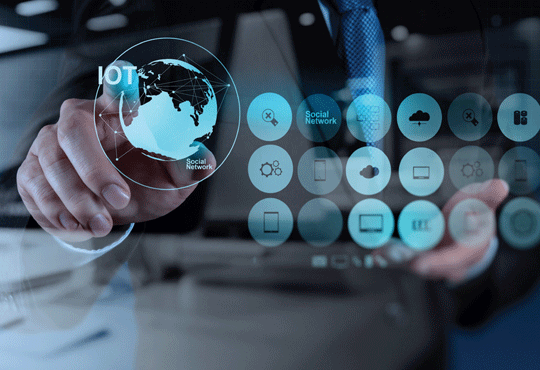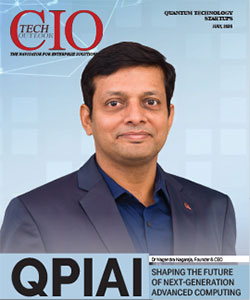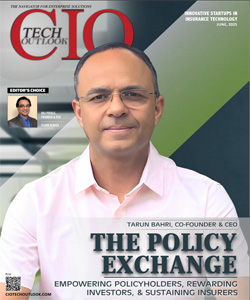Evolution of the IoT Landscape
Vinod Krishnan, Chief Information Officer, Indus Towers
 Indus Towers is one of India’s largest telecom tower companies with over 1,22,730 towers across 15 telecom circles. The company has the wide coverage in India and has already achieved 2,88,913 Tenancies, a first in the telecom tower industry globally.
Indus Towers is one of India’s largest telecom tower companies with over 1,22,730 towers across 15 telecom circles. The company has the wide coverage in India and has already achieved 2,88,913 Tenancies, a first in the telecom tower industry globally.
Over the last couple of years, IoT has moved from being a mere buzzword to a technology readily available to companies. Several product companies (especially in the consumer electronics and minor appliances space) have also moved on to the bandwagon of enabling their products to be IoT- ready. Many companies in the services and logistics space have also begun touting the benefits of transparency enabled by telematics and IoT, essentially, monetizing their own investments in technology made for their internal processes and creating new products and models to increase business and revenue. Most companies in the manufacturing space which had traditionally invested in machine-to-machine (M2M) communication and sophisticated control systems have also taken the logical step of investing in IoT technology.
"The data capturing, and acquisition front has seen an explosion of solutions, products and services, largely driven by competition among manufacturers to provide 'IoT ready' equipment"
The data capturing, and acquisition front has seen an explosion of solutions, products and services, largely driven by competition among manufacturers to provide ‘IoT ready’ equipment. Almost every equipment now comes in a default ‘smart’ mode enabled with on-board interfaces to transmit key operating data of that equipment for management and analysis.
On the data storage and analytics front, several partners have rushed in to support the anticipated large volumes of data being collected from IoT-enabled devices. Almost all the major cloud providers have suites of products and services available to sanitize, sense-check and process data flowing in from devices as well as to apply analytical methods to it, both in flight and at rest.
There are no clear leaders in this space yet, perhaps because there are not enough transformational success stories of organizations that have traversed the curve from data capture to storage to analytics and further to market success. Many of the early successes have come in use of captured data to drive real-time response. Not many organizations have collected enough data for statistical validity and application of these newly developed tools.
However, several factors continue to dog the landscape, effectively preventing this technology from delivering the benefits it has promised for so long.
-
Proprietary Legacy Technology: Smart controllers are abundant, but very few of them are smart in the same way. There is a great degree of proprietary technology, often locked by OEMs trying to enter the services space as a revenue enabler, or simply because of complicated or legacy electronics that are not widespread enough to attract the interest of a more generic service provider in this space.
2. No Clear Winners: Multiple competing data storage and analytics stacks are touted with much the same technical underpinnings. Even their front-end development and user interface tools do not vary much. This results in a very fragmented landscape with no clear winners or differentiators, causing hesitation for the enterprise buyers of this technology since they would not like to make significant investments and face the risk of backing the wrong partner.
3. Difficulty in Data Acquisition: It is still very difficult and painstaking to program the data acquisition from the device or controller to the database, with very few skilled professionals who understand the underlying hardware and technology stacks. Partners tend to be niche and the skill set is at a huge premium. Backhaul of data still presents difficulties and is still not fully reliable even in areas with excellent 3G/4G coverage.
So, is it all doom and gloom in terms of value realization from investments in IoT? Not really - but it is still an area where only the fearless or the foolhardy can enter with any degree of confidence.
The biggest challenges in IoT implementation, however, are cultural.
1. Leadership teams still need to evaluate the benefits of IoT programs carefully and drive strong change management to make use of the newly available information.
2. Investments need to be made very judiciously and with full commitment to moving the entire legacy base (not just the newest or latest devices) to avoid data holes and completeness concerns which may be used to derail the initiatives.
3. Potential for business model change and optimization needs to be recognized early and the preparedness of the rest of the environment (e.g. supplier contracts, manpower allocation) needs to be assessed and decisions taken on the eventual configuration of the business to make use of the information being received and the capabilities being added as a consequence of IoT implementation.
1. Long established channels of service and sales that have relied on personal visits to customers or sites have huge inertia and present their own version of ‘channel conflict’ to derail a concerted attempt to engineer new models of sales and service which are enabled through IoT.
2. Not all organizations are ready for the level of internal (to their employees) and external transparency (to their customers) that the newly acquired data provides. It is ironically much easier for a new company or organization to adopt and implement the technology than existing industry leaders with vast installed base of equipment and superior knowledge of the environment and customer.
As several leading organizations start to move along the curve and success stories emerge which can be validated by market share and revenue, expect a huge spurt in investment in and consumption of this technology. Clearly, the best days of IoT adoption are ahead of us!




